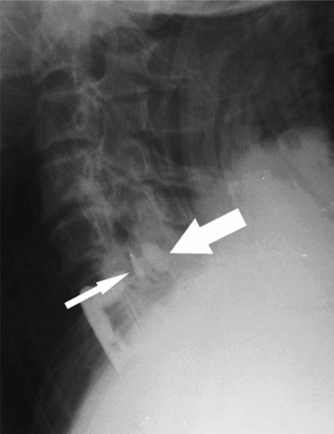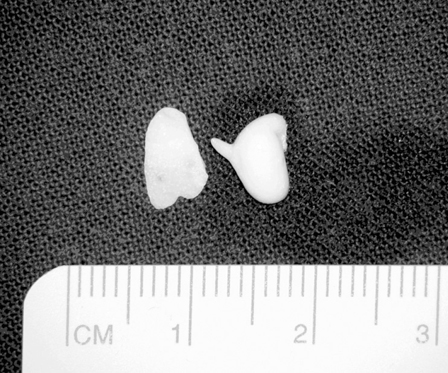Yonsei Med J.
2010 May;51(3):466-468. 10.3349/ymj.2010.51.3.466.
Serious Complication of Cement Augmentation for Damaged Pilot Hole
- Affiliations
-
- 1Department of Neurosurgery, CHA University College of Medicine, Seongnam, Korea. cistern@cha.ac.kr
- KMID: 1075005
- DOI: http://doi.org/10.3349/ymj.2010.51.3.466
Abstract
- Polymethl methacrylate (PMMA) screw reinforcement is frequently used in osteoporotic bone as well as in damaged pilot holes. However, PMMA use can be dangerous, since the amount of applied cement is uncontrolled. A 47-year-old male with traumatic cervical spondylolisthesis at C6-7 underwent anterior cervical plate fixation. During repeated drilling and tapping for false trajectory correction, a pilot hole was damaged. Although it was an unconventional method, PMMA augmentation was tried. However, PMMA was accidentally injected to the cervical spinal cord owing to lack of fluoroscopic guidance. The PMMA was surgically removed after corpectomy and durotomy. The patient had left side hemiparesis (Grade 2/5) immediately post operation. The patient improved spontaneously (Grade 4/5) except for 4th and 5th digit extension. Here, we report a rare complication of PMMA extrusion in the spinal cord during a damaged pilot hole injection, which has not previously been described.
Keyword
MeSH Terms
Figure
Reference
-
1. Pfeifer BA, Krag MH, Johnson C. Repair of failed transpedicle screw fixation. A biomechanical study comparing polymethylmethacrylate, milled bone, and matchstick bone reconstruction. Spine (Phila Pa 1976). 1994. 19:350–353.2. Chen YJ, Tan TS, Chen WH, Chen CC, Lee TS. Intradural cement leakage: a devastatingly rare complication of vertebroplasty. Spine (Phila Pa 1976). 2006. 31:E379–E382.3. Konno S, Olmarker K, Byröd G, Nordborg C, Strömqvist B, Rydevik B. The European Spine Society AcroMed Prize 1994. Acute thermal nerve root injury. Eur Spine J. 1994. 3:299–302.4. Shapiro S, Abel T, Purvines S. Surgical removal of epidural and intradural polymethylmethacrylate extravasation complicating percutaneous vertebroplasty for an osteoporotic lumbar compression fracture. Case report. J Neurosurg. 2003. 98:1 Suppl. 90–92.5. Wu CC, Lin MH, Yang SH, Chen PQ, Shih TT. Surgical removal of extravasated epidural and neuroforaminal polymethylmethacrylate after percutaneous vertebroplasty in the thoracic spine. Eur Spine J. 2007. 16:Suppl 3. 326–331.6. Hitchon PW, Brenton MD, Coppes JK, From AM, Torner JC. Factors affecting the pullout strength of self-drilling and self-tapping anterior cervical screws. Spine (Phila Pa 1976). 2003. 28:9–13.7. Conrad BP, Cordista AG, Horodyski M, Rechtine GR. Biomechanical evaluation of the pullout strength of cervical screws. J Spinal Disord Tech. 2005. 18:506–510.
Article8. Lei W, Wu Z. Biomechanical evaluation of an expansive pedicle screw in calf vertebrae. Eur Spine J. 2006. 15:321–326.
Article9. Schultheiss M, Claes L, Wilke HJ, Kinzl L, Hartwig E. Enhanced primary stability through additional cementable cannulated rescue screw for anterior thoracolumbar plate application. J Neurosurg. 2003. 98:1 Suppl. 50–55.
Article10. Pitzen TR, Drumm J, Bruchmann B, Barbier DD, Steudel WI. Effectiveness of cemented rescue screws for anterior cervical plate fixation. J Neurosurg Spine. 2006. 4:60–63.
Article11. Pitzen T, Franta F, Barbier D, Steudel WI. Insertion torque and pullout force of rescue screws for anterior cervical plate fixation in a fatigued initial pilot hole. J Neurosurg Spine. 2004. 1:198–201.
Article12. Wittenberg RH, Lee KS, Shea M, White AA 3rd, Hayes WC. Effect of screw diameter, insertion technique, and bone cement augmentation of pedicular screw fixation strength. Clin Orthop Relat Res. 1993. (296):278–287.13. Hernigou P, Ma W. Open wedge tibial osteotomy with acrylic bone cement as bone substitute. Knee. 2001. 8:103–110.
Article
- Full Text Links
- Actions
-
Cited
- CITED
-
- Close
- Share
- Similar articles
-
- Anchor Hole Augmentation with Bone Cement in Arthroscopic Rotator Cuff Repair
- Cement Augmentation of Pedicle Screw Instrumentation: A Literature Review
- PHILOS plate fixation with polymethyl methacrylate cement augmentation of an osteoporotic proximal humerus fracture
- Cement-Augmented Pedicle Screw Fixation in Patients with Osteoporosis : Safety, Efficacy and Complications
- Cardiac Perforation Caused by Bone Cements as a Complication of Cement Augmented Pedicle Screw Fixation Using the Fenestrated Pedicle Screw: A Case Report




